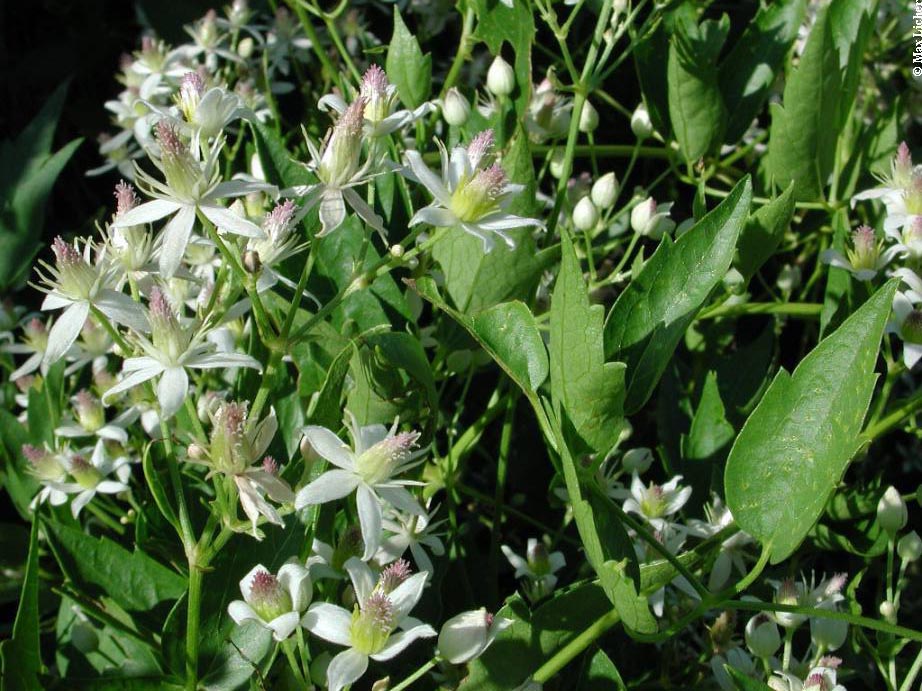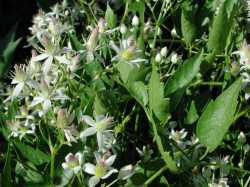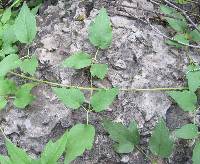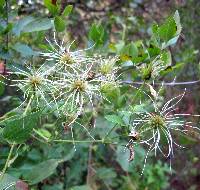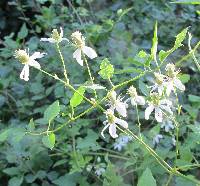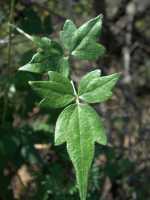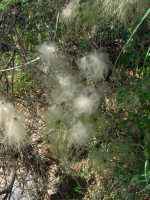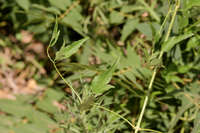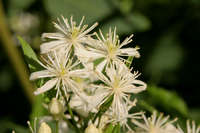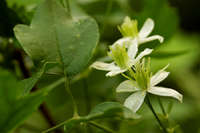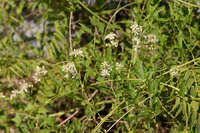Stems clambering or climbing, to 6(-20) m. Leaf blade pinnately 5-foliolate or 2-pinnate and 9-15-foliolate, somewhat succulent; leaflets lanceolate to broadly ovate, lobed or unlobed, (1-)3-9 × 0.9-7.2 cm, margins entire or variously toothed; surfaces abaxially glabrous or sparsely pilose or silky, especially on veins; ultimate venation obscure. Inflorescences axillary, usually 7-20(-65)-flowered compound cymes, often distinctly corymbiform, flowers crowded. Flowers unisexual; pedicel slender, 0.5-3 cm; sepals wide-spreading, not recurved, white to cream, obovate to oblanceolate, 6-10 mm, abaxially and adaxially pilose; stamens 25-50; staminodes absent or fewer than stamens; pistils 25-65. Achenes elliptic, 3-3.5 × ca. 1.5 mm, prominently rimmed, silky; beak 3-3.5 cm. 2 n = 16.
Flowering summer (Jun-Sep). Forest edges, woods, riparian deciduous woodlands, moist wooded draws, scrub, secondary sites derived from these, or clearings and pastures, usually near streams or on moist slopes; 0-2600 m; Alta., B.C., Man., Sask.; Ariz., Calif., Colo., Idaho, Mont., Nebr., Nev., N.Mex., N.Dak., Oreg., S.Dak., Utah, Wash., Wyo.; nw Mexico.
Clematis ligusticifolia is the common virgin's-bower in the western United States and Canada. In California it might hybridize with C. lasiantha . In Mexico it is found only in the extreme north; it is probably related to the Mexican and Central American species, C . grossa Bentham.
The name Clematis neomexicana has been applied to the populations with crenate leaflets in New Mexico and northern Chihuahua. This distinction is tenuous, however, given the wide variation present in leaflet margins within this and other species in Clematis subg. Clematis .
Two varieties of Clematis ligusticifolia have been weakly distinguished based on the presence or absence of 2-pinnate leaves.
Infusions prepared from the plants of Clematis ligusticifolia were used medicinally by Native Americans as a wash for skin eruptions, a lotion for backaches or swollen limbs, and a lotion to protect one against witches; stems and leaves were chewed to treat colds and sore throats; decoctions of leaves were also used as a wash and for stomachaches and cramps; and lathers of leaves were used to treat boils on humans and on animals (D. E. Moerman 1986).
Duration: Perennial
Nativity: Native
Lifeform: Vine
General: Perennial herbaceous vine from a woody base; stems climbing or trailing, up to 6 m long.
Leaves: Opposite along the stems, on long petioles; leaves pinnately compound with 5-7 leaflets, each on a petiolule; leaflets lanceolate to broadly ovate, toothed, sparsely hairy.
Flowers: White and showy, in long-peduncled cymes at leaf axils; male and female flowers on separate plants (dioeceous); sepals 4, petal-like, 6-12 mm long, white to cream; petals absent.
Fruits: Achenes in a dense cluster, each with a long, plumose persistent style, 3-5 cm long.
Ecology: Found along streams, from 3,000-8,500 ft (914-2591 m); flowers May-September.
Distribution: British Columbia, CAN to ND; south to CA, AZ and NM
Notes: This species is a perennial vine with clusters of attractive white flowers, followed by showy starburst-like clusters of achenes with long feathery tails. Distinguished from other Clematis spp. by the flowers in clusters (several species have solitary flowers); the tails of the achenes less than 5 cm long; and the green herbage (C. drummondii has flowers in clusters but the achenes have tails greater than 5 cm long and the herbage is gray-pubescent).
Ethnobotany: Native Americans used the roots as a stimulant for exhausted or dehydrated horses. The plant was chewed as a cold remedy and to cure sore throats.
Etymology: Clematis is from the Greek clema, plant shoot, an ancient name for a vine; ligusticifolia means the leaves resemble those of Ligustrum, the genus of privet, a tree in Oleaceae, the olive family.
Synonyms: C. neomexicana, C. suksdorfii
Editor: SBuckley 2010, AHazelton 2017


